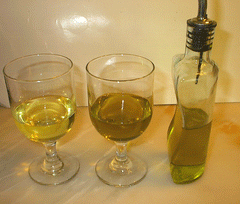Easy recipe for beautiful skin!
I love that some things are easy in life because so many aren't. This is one of those easy things and it really does make a difference in the look and feel of your skin. I know I have days when my skin looks vibrant and other days when it just looks drab (today for instance) - which is why I started reading one of the books on my shelves. I use the same facial regimen every day that I know to be effective and healthy, but sometimes you just have to start from the inside to achieve that healthy look. You need a juicer though - the kind with names like Champion that extracts the juice from the vegetable or fruit and expels the pulp. We got ours used for about $25.00 - just let people know you're looking for one. Or you can opt for a new one. I have an article somewhere that I wrote about which brands and types are available. Will have to find that.This recipe was adapted from Juicing, Fasting and Detoxing For Life by Cherie Calbom, MS.
BEAUTIFUL SKIN COCKTAIL
1 cucumber, peeled
1 parsnip, peeled
2 to 3 carrots, scrubbed well (peeled if not organic), tops removed
1/2 lemon, peeled
1/4 green bell pepper (Opt for the red if available, more vitamin C and phytonutrients, see below)
Cut fresh produce to fit your juicer's feet tube. Juice ingredients and stir gently to blend. Pour into a clear glass (I like to see the colors shining through) and drink as soon as possible. Precious vitamins and minerals are lost with each passing minute. Savor the taste - don't just gulp it down. This should make 1 to 2 glasses.
Why this cocktail?
Well, many reasons but I'll address mostly the benefits from bell peppers. However, carrots also contain a huge amount of carotenoids and vitamin A and contribute a great deal to healthy skin plus helping protect skin from UV damage. Below are other benefits from this particular juice:
1. Silicon - cucumber, parsnip and bell pepper are good sources of the trace mineral silicon, which is recommended to strengthen skin, hair, and fingernails along with bones. In studies silicon has been shown to reduce signs of aging such as improving thickness of skin and reducing wrinkles. Silicon - not to be confused with silicone, refers to natural materials whereas silicone refers to man-made materials. Silicon is a nonmetallic element with the atomic weight of 28. Silicon increases absorption of calcium. As we age, silicon becomes depleted, so it can be an important addition to our diet as we age. There is no daily intake requirement but it is important that silicon be consumed on a daily basis.
2. Vitamins - Bell pepper contains more than 30 different carotenoids. Carotenoids provide antioxidant and anti-inflammatory health benefits. Bell pepper is also an excellent source of vitamin C - two times the amount of vitamin C found in your typical orange. Red peppers have twice as much vitamin C as green ones. Go for the red! Every good Nebraskan knows that!!
Bell pepper is also a good source of another antioxidant vitamin--vitamin E. German researchers report that the antioxidants vitamin E, selenium, and carotenoids - lutein, lycopene and beta-carotene - improve various aspects of skin health and reduce the effects of skin aging. "Subjects supplemented with the antioxidants in both groups also experienced a significant increase in skin density and thickness. In addition, roughness, scaling and wrinkling of the skin improved in both groups of subjects receiving the antioxidants." (1)
Bell peppers contain a substantial amount of vitamin A with ripened red peppers having almost 16 times the amount of vitamin A than green bell peppers. According to WebMd, vitamin A is necessary for the maintenance and repair of skin tissue. "Without it you'll notice the difference." (2). Although being pharmaceutical-minded, they also recommend topical vitamin A creams. I have no doubt that increasing your intake of natural vitamin A would be much better - Mother Nature really does know best.
Increasing our regular intake of antioxidant phytonutrients can decrease our oxidative stress and lower our levels of inflammation, both of which contribute to dry, aging skin and wrinkles.This is but one of many juicing recipes that can be easy and very inexpensive to do. There are many other health benefits beyond healthy skin, but usually the health of our bodies is directly reflected in the healthy appearance of our skin.
Thanks for listening!

1. Source: Heinricha U, Tronniera H, Stahlb W,
Béjotc M, Maurettec JM. Antioxidant Supplements Improve Parameters Related
to Skin Structure in Humans. Skin Pharmacology and Physiology.
2006;19:224-231.
2. http://www.webmd.com/skin-problems-and-treatments/features/skin-nutrition?page=2




















